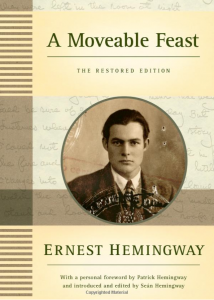A Moveable Feast by Ernest Hemingway
In my writing and reading, I am studying Earnest Hemingway. That led to my reading of A Moveable Feast, published in 1964 after he had died. The version I have includes a foreword by his son, Patrick, and an introduction by his grandson, Sean. There are also many newly released sketches about his son Jack and his first wife, Hadley.

A Moveable Feast, my review of Ernest Hemingway’s book.
Hemingway and the Fitzgeralds
The chapters about F. Scott Fitzgerald and the subsequent descriptions including his wife, Zelda Sayre, formerly of Montgomery, Alabama add a new level of color to the first celebrities of the Jazz Age. (Check out the short film I did last summer on Zelda as a ghost in Montgomery–going back home one night and visiting her old haunts in modern Montgomery.)
Hemingway paints a picture of Zelda that is anything but flattering. He all but says that Zelda ruined Scott’s writing career out of jealousy. Fitzgerald is portrayed in firsthand stories that show why he only produced a limited number of books in his career.
For instance, when they first met, Scott invited Hemingway to take a train with him from Paris to Lyon to retrieve a car Scott and Zelda had left broken down. Hem arrived at the train, but Scott did not. Hem boarded, Scott did not. Hem arrived in Lyon, and Scott arrived an hour later.
Hem booked a room and wired Zelda where he was staying, but the message never got to Scott, who found Hem the next morning. Then there was the matter of where the two would eat breakfast. Zelda apparently hated cars with tops and so theirs had none and it was raining that day. Scott and Hem made it an hour before they had to stop in the rain. Once they stopped for the day, Scott said he felt like he was catching his death of cold. Hem kept insisting that he had no temperature and that he was fine.
Scott insisted he was dying. He insisted Hem find a thermometer. The pharmacy was closed. Hem found a waiter who located an odd thermometer which he told Scott, “You’re lucky it’s not a rectal thermometer.” No temp, but that didn’t satisfy Scott.
But after some doing, he then went downstairs to call Zelda and talked to her for an hour. This, he assured Hemingway was the first night the two had spent apart since they’d been married. The way Hem told it, it was a gross case of co-dependency before anyone used the term. The whole bit makes one wonder how stable Scott was himself. Then to see how Hemingway portrays the constant fighting between Scott and Zelda is eye-opening.
The first season TV series on Amazon shows they have a contentious relationship but Hemingway paints a much harsher picture. At one point they are arguing with their chauffeur from France about whether or not they can put oil in their car, or whether or not their driveway is theirs or not.
But there are a few segments of the book where Hemingway writes about writing. “On Writing in The First Person,” Hemingway says that if a writer does a good enough job, “you make the person who is reading … believe that the thing has happened to him too.” He goes on to say that if one can achieve this it will “become part of the reader’s experience and a part of his memory.”
The observations and sketches about living in Paris in the early 1920s are colorful and enjoyable. He shares what it was like to live poor and to work hard at honing his craft. He was in love with Hadley and focused, intent on becoming a serious writer and loving living in what he felt was the best place in the world to be a writer at the time.
The chapters about Gertrude Stein and her calling Hemingway’s “the lost generation” are informative, as well as his summation that every generation is a little lost.
I enjoyed the read and will likely go back through this one a couple more times in my studies. There are Easter eggs hidden here among his feast of words.
My Reading List
In 2016, I began reading like a madman. In those days, my revisions to one of my manuscripts were in full swing and I intended to get a better idea of what was selling in the way of novels.
There’s only one good way to accomplish such a feat–reading everything in sight.
And so I did, and still have a stack of books with me constantly that are in a To Be Read pile.
I encourage you to check out my Reading List.






“Arguing about …..whether their driveway is there’s”? Not a mistake I would expect from a writer!
We are all human, Bobbie. Thanks for the catch. I’m fixing it now.